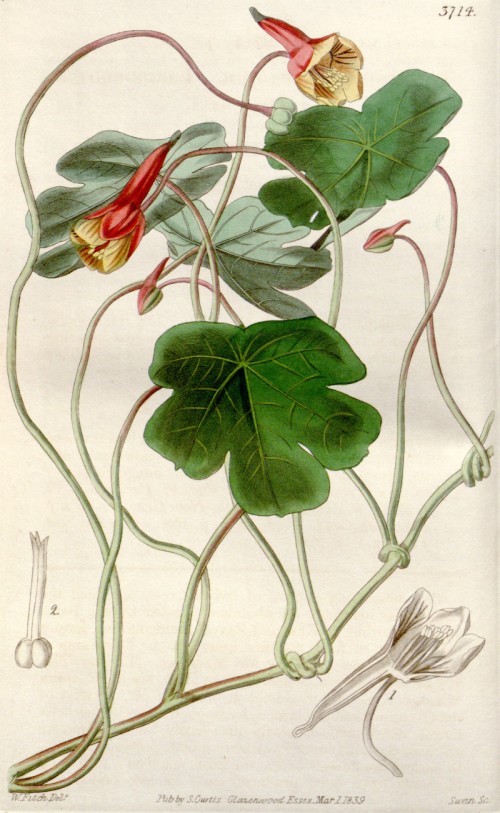Tropaeolum tuberosum Ruiz & Pav. - Tropaeolaceae - mashua, isaño, Knollige Kapuzinerkresse
Climbing perennial herb, up to 2(-4)m high; native to the central Andes (Bolivia, Colombia, Ecuador, Peru); flowers tubular, showy bi-coloured, sepals orange-red, petals bright yellow.
Mashua is grown its edible tuber (containing carbohydrates and ascorbic acid) and as a companion crop to repel pests in potato fields.
http://en.wikipedia.org/wiki/Tropaeolum_tuberosum
„Already the Inka have protected their potato fields by mashua (Tropaeolum tuberosum) against pests. A few mashua plants around the field are sufficient to protect potato plants.“
[Mithöfer, A. and Schuman, M. C. (2014), Subtile Verteidigungsstrategien in Pflanzen. Biologie in unserer Zeit, 44: 26–32. doi: 10.1002/biuz.201410525]
http://onlinelibrary.wiley.com/doi/10.1002/biuz.201410525/full
Folkloristic medicinal use showes that eating the tubers may have beneficial effects for kidney and bladder.
[Johns, Timothy Allan. „Ethnobotany and phytochemistry of Tropaeolum tuberosum and Lepidium meyenii from Andean South America.“ (1980).]
„The nutritional value of mashua is high… The antibiotic, insecticidal, nematocidal, and diuretic properties of isothiocyanates substantiate several uses of mashua in Andean folk medicine… Mashua has the potential to become a major food plant around the world. The pest and pathogen resistance, high yield, nutrient content, and ease of cultivation make mashua an excellent candidate for further research“
http://opensiuc.lib.siu.edu/cgi/viewcontent.cgi?article=1434&context=ebl
„Analysis of the isothiocyanates arising from enzymatic hydrolysis of glucosinolate extracts of Tropaeolum tuberosum supports the assessment of two subspecies. Seeds, tubers, leaves and flowers of T tuberosum subsp. tuberosum produced p-methoxybenzyl isothiocyanate. Subspecies silvestre produced benzyl-, 2-propyl- and 2-butylisothiocyanates. N, N-Di(4-methoxybenzyl)thiourea was detected in tuber extracts of subsp. tuberosum by HPLC.“
[Isothiocyanates and thioureas in enzyme hydrolysates of Tropaeolum tuberosum. Timothy Johns, G.H. Neil Towers, Phytochemistry, Vol.20(12), 1981, 2687–2689]
„Freeze-dried extract of mashua had 3.7 g 100 g−1 of benzyl glucosinolate. Mashua-treated rats showed a reduction in testicular spermatid number and DSP from day 12 to day 42; meanwhile, the effect of mashua was noted in epididymal sperm count after 12 and 42 days of treatment. In addition, epididymal sperm transit time was delayed at day 7 and it was accelerated on days 12 and 21 of treatment. No differences in serum testosterone levels were found between rats treated with vehicle and mashua after 42 days of treatment. Finally, mashua reduces testicular function after one spermatogenic cycle by reducing spermatid and sperm number, DSP and epididymal sperm transit time.“
[Tropaeolum tuberosum (Mashua) reduces testicular function: effect of different treatment times. Cárdenas‐Valencia, I., Nieto, J., Gasco, M., Gonzales, C., Rubio, J., Portella, J., Gonzales, G. F., Andrologia, Vol.40(6), 2008, 352-357]

Curtis’s Botanical Magazine, vol.66 [ser.2, vol.13], t.3714 (1840) [W.H.Fitch]
http://plantgenera.org/species.php?id_species=1038349